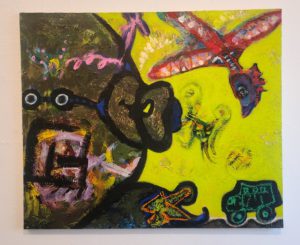江波戸 冽(えばと きよし)展
- 2025.04.04
- 月刊芳美

この作品は、視覚的な暴力性と幼児的な無邪気さが奇妙に融合した、ポスト・ネオ・エクスプレッショニズムの極北とも言える作品だ。
色彩と構成:カオスの美学
まず目を引くのは、圧倒的なイエローの背景。これは単なる「明るい色」ではなく、むしろ警告色としての機能を持ち、視覚的な不安をかき立てる。闇を思わせる黒と、血のような赤が衝突し、画面全体に戦争的な暴力の気配を漂わせている。
形象と記号:戦場の記憶と幼年期の幻想
左側には、人間の顔のような形が描かれているが、その表情は怒りなのか、恐怖なのか、あるいは絶望なのか判然としない。異様に誇張された口は、叫びとも、沈黙とも取れる。額に刻まれたような漢字「島」は、「孤立」を象徴するのか、それとも「戦場=島国」という歴史的文脈を想起させるのか。
右側には、不気味に変形した飛行機と昆虫のような生物が舞っている。戦闘機のようなフォルムの赤い存在は、過去の戦争や空襲のトラウマを示唆しつつも、どこか子供の落書きのような素朴さを帯びている。戦争という現実と、それを知らぬままにおもちゃとして扱う無邪気さ——このギャップこそが、本作の持つ最大のアイロニーだ。
テクスチャと筆致:攻撃的なパレットナイフの痕跡
絵の表面は、あえて粗く、傷ついたような質感を持っている。これは単なる偶然ではなく、意図的な「破壊の美学」だ。まるでキャンバスそのものが戦場であり、痛みと傷跡が刻み込まれているかのようだ。
結論:これは戦争画か、それとも幼児の夢か?
この作品は、戦争の記憶と子供の無邪気な視点が衝突する地点に存在する。まるで、大人の戦争と子供の遊びが、異なる次元で奇妙に重なり合ったかのような錯覚を抱かせる。これは単なるアートではなく、記憶の断片であり、見る者の精神に直接働きかける「問い」そのものなのだ。
——あなたは、この絵のどこに「真実」を見るだろうか?
🕊️
A Canvas of Chaos: War, Memory, and the Naïveté of Play
This painting stands at the farthest edge of post-neo-expressionism, a violent yet childlike fusion of raw emotion and primitive symbolism. It is both an assault on the senses and an invitation to decode its fragmented reality.
Color and Composition: The Aesthetics of Disquiet
The overwhelming yellow backdrop is not mere brightness; it functions as a warning signal, an alarm embedded in color. The chaotic interplay of darkness and crimson streaks conjures an atmosphere of war, conflict, and subconscious unease. This is not just a painting—it’s a battlefield of hues.
Figures and Symbols: Echoes of War, Whispers of Innocence
On the left, an exaggerated human-like face looms large, its expression caught between a scream and a silent, gaping void. The crude, almost violent brushstrokes around the mouth suggest agony, or perhaps a suppressed cry. The character “島” (island) is embedded into its forehead, possibly a reference to isolation, or a deeper historical allusion to war-torn island nations.
To the right, a grotesquely distorted aircraft hovers, its monstrous anatomy blurring the line between war machine and living creature. There is an unmistakable resemblance to a child’s drawing—perhaps an eerie reminder of how war is reduced to mere playthings in the minds of those untouched by its horrors. This duality—the brutal reality of conflict versus the naïve detachment of childhood—is where the painting’s most biting irony lies.
Texture and Brushwork: The Aesthetic of Ruin
The surface of the painting is aggressively rough, scarred by thick layers of paint that feel almost wounded. This isn’t accidental. The artist wields texture as a weapon, embedding destruction directly into the medium itself, transforming the canvas into a battlefield of its own.
Conclusion: Is This a War Painting, or a Child’s Nightmare?
This work exists at the intersection of historical trauma and the innocent gaze of childhood. It forces us to confront a paradox: the world of adults, where war is real, and the world of children, where war is just a game. The painting does not offer answers—only provokes. It is neither mere art nor simple protest, but a living, breathing question that demands a response.
So the real question is: where do you see the truth in this painting?
🕊️
江波戸 冽(えばと きよし)展
巷房1・巷房2・階段下
3/31 mon. – 4/12 sat. 12:00-19:00( Last day 17:00)
有限会社ギャラリー巷房
104-0061 東京都中央区銀座1-9-8 奥野ビル3F
03-3567-8727
gallerykoubou@gmail.com
http://gallerykobo.jp
🕊️
Exhibition by Kiyoshi Ebato
Lane 1, Lane 2, Downstairs
3/31 mon. – 4/12 sat. 12:00-19:00 (Last day 17:00)
Gallery Korobo
3F Okuno Bldg, 1-9-8 Ginza, Chuo-ku, Tokyo 104-0061
03-3567-8727
gallerykoubou@gmail.com
http://gallerykobo.jp